You are here
Why were commercial planes still flying over Ukraine?
By AFP - Jul 19,2014 - Last updated at Jul 19,2014
SEOUL — The downing of a Malaysia Airlines jet over rebel-held eastern Ukraine has raised questions over why the company persisted in flying in conflict-zone airspace that many other Asian carriers had abandoned months ago.
The air corridor over Ukraine has always been a crowded one for flights between Europe and Asia — particularly Southeast Asia — and re-routing around the airspace would mean an increase in flight time and fuel costs.
Nevertheless, a number of major Asian airlines, including South Korea’s Korean Air and Asiana, Australia’s Qantas and Taiwan’s China Airlines, said Friday that they had started avoiding the area as much as four months ago, when Russian troops moved into Crimea.
“We stopped flying over Ukraine because of safety concerns,” Asiana spokeswoman Lee Hyo-Min said.
Korean Air moved its flight paths 250 kilometres south of Ukraine from March 3 “due to the political unrest in the region”, an official for the carrier told AFP.
A Qantas spokeswoman said its London to Dubai service used to fly over Ukraine, but the route was changed “several months ago”, while Taiwan’s China Airlines diverted its flights from April 3.
Hong Kong’s Cathay Pacific and Pakistan International Airlines said their flight paths had changed “some time” ago.
‘Safe’ flight path?
Asked why Malaysia Airlines had not taken similar precautions, Transport Minister Liow Tiong Lai stressed that international air authorities had deemed the flight path secure.
“The flight path taken by MH17 was approved by the International Civil Aviation Organisation (ICAO), and by the countries whose airspace the route passed through,” the minister told reporters in Kuala Lumpur.
“In the hours before the incident, a number of other passenger aircraft from different carriers used the same route,” he noted.
But ICAO spokesman Anthony Philbin said the UN agency, which is headquartered in Montreal, “does not establish routes” for airlines to follow.
Tyler said an airline’s choice of flight route was “very similar to driving a car — if the road is open, you assume it is safe. If it’s closed, you find an alternate route”.
According to the European flight safety body Eurocontrol, the doomed plane was flying at a level known as “330”, or approximately 10,000 metres or 33,000 feet.
The route had been closed to level “320” but was cleared for those flying at the Malaysian plane’s altitude.
In a statement late Friday, the airline said MH17 had filed a flight plan requesting to fly at 35,000 feet which was “close to the ‘optimum’ altitude”.
“However, an aircraft’s altitude in flight is determined by air traffic control on the ground. Upon entering Ukrainian airspace, MH17 was instructed by Ukrainian air traffic control to fly at 33,000ft,” it said.
European and US airlines re-routed their flights as Kiev said flight MH17 was shot down in a “terrorist” attack, and a US official said intelligence analysts “strongly believe” it was downed by a surface-to-air missile.
Analysts were divided on whether carriers like Malaysia Airlines had been negligent in opting to continue flying over Ukraine.
“I just find it astonishing. I am absolutely flabbergasted,” said Geoff Dell, an air safety expert from the University of Central Queensland in Australia, told Sky News.
“If there’s trouble spots on the globe, then you take a decision to avoid that area,” Dell told Sky News.
“You don’t put your primary assets — your passengers, your crew, your airplane — at risk unnecessarily,” he added.
Assessing risk
Malaysia Airlines was certainly not alone in persisting with the corridor over Ukraine.
A host of Asian carriers, including Singapore Airlines, Air India, Thai Airways, Air China, China Eastern Airways and Vietnam Airlines, had used the same airspace up until Thursday’s crash.
And European airlines such as Lufthansa and Air France, as well as US carrier Delta, said they were only now taking the decision to avoid Ukraine entirely.
Gerry Soejatman, a consultant with the Jakarta-based Whitesky Aviation chartered flight provider, said every airline had its own level of risk assessment.
Flying above 30,000 feet is generally considered secure given the level of training and sophisticated weaponry required to shoot down a plane at that height, Soejatman said.
“Ten years ago you’d be an idiot to fly over Iraq below 15,000 feet, but over 30,000 feet was very safe, so it’s about the level of risk.
“I think this will send a message to airlines to have a closer look at conflict zones when they choose to fly over them and gain a better understanding of what equipment is on the ground,” he said.
Related Articles
SINGAPORE - Pan-European air traffic control agency Eurocontrol on Tuesday warned airlines to exercise caution in the eastern Mediterranean
Any airline would struggle with the devastating impact of losing one jet full of passengers, especially if it had already been bleeding money for years.
Armed groups in Syria have an estimated several hundred portable anti-aircraft missiles that could easily be diverted to extremists and used to destroy low-flying commercial planes, according to a new report by a respected international research group. It cites the risk that the missiles could be smuggled out of Syria by terrorists.
















